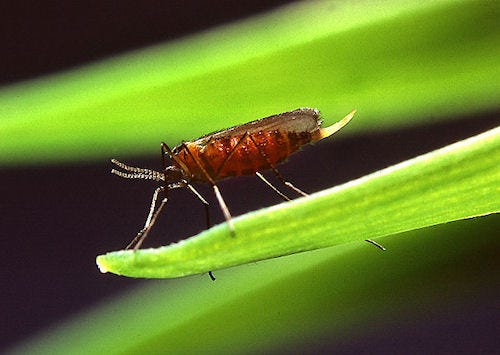February 23, 2012

Jonathan Nixon, South Dakota State University Extension entomologist, says the Hessian fly could be a problem in wheat this year.
The adult Hessian fly is darkly colored with mosquito-like appearance, approximately 1/8-inch long when fully developed. Adults emerge between August and November depending on location and environmental factors (temperature specifically). Mated females (lay) 250-300 eggs within fall-seeded wheat leaves during their short life span of four days. The red, oblong eggs are found in groups of 2-15 laid end to end just within the upper leaf surface.

A Hessian fly feeds on a wheat plant. Photo: Purdue
Within 10 days of egg laying tiny, translucent, and legless larvae emerge and begin feeding within the leaf. Larvae are not capable of surviving outside of the host plant and, therefore, continue to develop into the adult stage while inside the plant. Larvae damage the plant tissue while feeding. Their mouth parts work much like sandpaper and as they scrape their mouths against the leaf tissue, they suck up the juices released by the plant. Excessive feeding by even a single larva for even a few days can stunt plant growth. As feeding continues, the plant becomes brittle and the leaves take on a bluish green color.
The larvae reach maturity within 30 days of egg emergence depending on temperature and humidity and measure 3/16 inch long. At maturity the larvae form brown pupae or puparia, commonly referred to as "flaxseeds," that are about 1/8 inch long. Overwintering occurs while in this stage and adults emerge between April and May.
Protecting wheat
Nixon says management of this pest can be difficult to establish.
"Insecticide applications are not typically recommended because the proper timing of these treatments is extremely difficult to achieve. In the spring, parasitism can significantly reduce Hessian fly populations. However, parasitism alone will not protect your fields from Hessian fly damage."
He says the best way to protect a crop is by selecting and planting certified varieties of Hessian fly resistant wheat, planting after the fly-free date in the fall and utilizing crop rotations.
"Be wary of the Hessian fly and what its damage looks like. This pest is just one reason to stress the importance of scouting your field for pest and disease damage as a method of preventing any major problems before they become a major issue. South Dakota wheat producers have faced this pest in the past. In the mid to late '80s Hessian fly populations blew up and caused a serious problem for wheat producers. However, that problem was short lived and since then populations have dropped well below any level of concern in South Dakota."
Nixon says SDSU Extension will do its part to warn producers if the fly once again becomes a problem in the state.
"Throughout the summer Extension agronomists will be scouting for early signs of Hessian fly problems, and will offer reports throughout the summer," Nixon says.
The Hessian fly isn't native to the U.S. Scientists think was brought in the straw bedding Hessian soldiers brought to the U.S. during the Revolutionary War. It was first discovered near a Hessian soldier encampment in 1779.
Source: SDSU
You May Also Like




